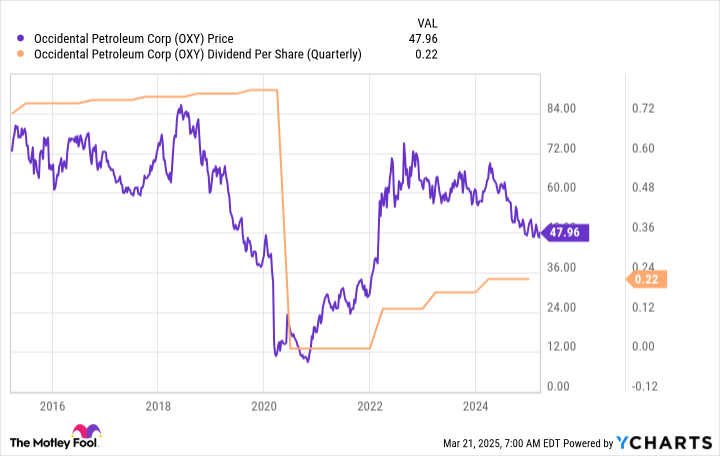Warren Buffett, the CEO of Berkshire Hathaway, is followed with almost religious zeal on Wall Street. When he openly backs a company, it often leads others to buy that stock without question. Occidental Petroleum (OXY -0.30%) has received Buffett's support. But most investors looking for energy exposure would probably be better off with one of these two oil giants (one of which is owned by Berkshire Hathaway, too).
What Buffett did for Oxy
It may seem like a lifetime ago at this point, but in 2019 Chevron (CVX 0.69%) was attempting to buy Anadarko Petroleum. Occidental Petroleum, often just known as Oxy, stepped in with a counteroffer. In the end, Oxy won out thanks to Buffett and Berkshire Hathaway providing it with the financial assistance it needed to outbid Chevron. Chevron chose to walk away instead of getting into a bidding war that might lead to overpaying for Anadarko.
The deal left Oxy heavily in debt, and when oil prices plunged during the early days of the coronavirus pandemic in 2020, the company cut its dividend. The dividend is not yet back to its pre-cut level. This isn't to suggest that Oxy is a bad energy company. In fact, it has been working on expanding its business and doing a reasonably good job of it. It recently bought CrownRock, for example, further expanding its position in the U.S. market. But many long-term investors won't be well served by the company's approach, particularly if creating a reliable and resilient income stream is part of the goal of buying an energy stock.
Decades of proof from ExxonMobil and Chevron
Income investors who care about dividend consistency will find ExxonMobil (XOM 0.01%) and Chevron much more attractive. ExxonMobil has increased its dividend annually for 42 consecutive years, while Chevron's streak is up to 37 years. A notable difference between Oxy and these two integrated energy giants is found on the balance sheet.
OXY Debt-to-Equity Ratio data by YCharts.
While Oxy's debt-to-equity ratio has fallen dramatically since the post-Anadarko spike, it is still multiples of the levels of leverage at ExxonMobil or Chevron. This is important because ExxonMobil and Chevron take on debt during industry downturns to support both their businesses and their dividends. Having ample leeway to do this protects their shareholders. Oxy doesn't have as much leeway.
Further adding to the attractiveness of ExxonMobil and Chevron are their size and diversification. With operations spanning from the upstream (energy production) through the midstream (pipelines) and into the downstream (chemical and refining), their business models help to soften the normal peaks and valleys of the energy cycle. Add in global footprints and market caps of $500 billion for ExxonMobil and $290 billion for Chevron, and they have a scale and reach (business-wise and financially) that $45 billion-market-cap Oxy really can't match.
Then there's the merely modest income stream you'll generate with Oxy and its 2% dividend yield. The average yield for an energy stock is 3.1%. ExxonMobil's yield is 3.4%, and Chevron's yield is 4.1%. Add it all up, and for both income-focused investors and conservative investors, Oxy should probably be replaced by either ExxonMobil or Chevron.
There's one more Buffett wrinkle
In something of an interesting twist, Occidental Petroleum isn't the only oil stock that Warren Buffett owns in Berkshire Hathaway's portfolio. He also owns Chevron. So, if you want an energy stock with Buffett's support, going with Chevron over Oxy doesn't actually lose you anything. That said, if you prefer to stick with industry giants, then ExxonMobil should be your pick. Either one will likely be a better choice for investors focused on safety and income.






